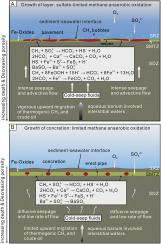当前位置:
X-MOL 学术
›
Gondwana Res.
›
论文详情
Our official English website, www.x-mol.net, welcomes your
feedback! (Note: you will need to create a separate account there.)
Hydrocarbon-seep deposits in the lower Permian Angie Formation, Central Lhasa Block, Tibet
Gondwana Research ( IF 7.2 ) Pub Date : 2021-02-01 , DOI: 10.1016/j.gr.2020.10.017 Chao Liu , Xianyin An , Thomas J. Algeo , Axel Munnecke , Yujie Zhang , Tongxing Zhu
Gondwana Research ( IF 7.2 ) Pub Date : 2021-02-01 , DOI: 10.1016/j.gr.2020.10.017 Chao Liu , Xianyin An , Thomas J. Algeo , Axel Munnecke , Yujie Zhang , Tongxing Zhu

|
Abstract Methane seepage along continental margins has been linked to climatic warming, yet it is uncertain whether such seepage took place during the Permian, a period that witnessed a transition from an icehouse to a greenhouse world. To address this issue, we investigated calcareous concretions and layers within mudstones/shales of the Kungurian Angie Formation in the Xainza area, central Tibet. A combination of petrographic, mineralogical, elemental, and carbon‑sulfur isotopic analyses provide strong evidence for a hydrocarbon-seep origin of these carbonates, with thermogenic methane and crude oil being the most likely carbon sources. Our dataset also indicates that, although fueled by a common deep-buried hydrocarbon reservoir, these layers and concretions experienced different biogeochemical processes due to variable rates of cold-seep fluid flux combined with persistently low sulfate concentrations in bottom waters of the Bangong-Nujiang Tethyan Ocean. A biogeochemical switch from sulfate-dependent to iron oxide-coupled anaerobic oxidation of methane in the sulfate-methane transition zone, likely triggered by sulfate exhaustion, was inferred to affect carbonate layer formation near the sediment-water interface. If true, this switch, together with common vent structures, would have resulted in escape of large amounts of methane directly to the ocean-atmosphere system. The hydrocarbon seeps in the central Lhasa Block was approximately coeval with rapid climate warming in the peri-Gondwanan region during the early Kungurian. Although further investigations are required in the future, this study demonstrates a possible causal relationship between regional tectonic evolution, hydrocarbon seepage, and global climate change.
更新日期:2021-02-01











































 京公网安备 11010802027423号
京公网安备 11010802027423号